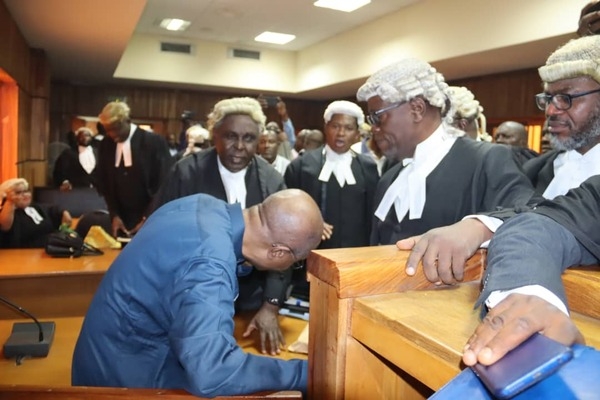Former Currency Operations Director at the Central Bank of Nigeria (CBN) Ahmed Bello Umar stunned a High Court of the Federal Capital Territory (FCT) in Maitama that the directive of former President Muhammadu Buhari on naira redesign was not followed.
He told the court that the redesigned naira notes produced under ex-Governor Godwin Emefiele were different from the specifications approved by the former president.
Umar, who said he was in office during the naira redesign, said although President Buhari gave approval on October 13, 2022 for a specific design of the 1000, 500 and 200 naira notes, the approved specification by the then president was allegedly altered.
He was testifying in the trial of the former CBN boss on alleged unlawful printing of naira notes.
Led in evidence by prosecuting lawyer, Rotimi Oyedepo (SAN), Umar said the CBN Act requires that when new notes were to be printed there should be a recommendation of the CBN Board of Directors to the president.
He added that the Act said the president shall approve the form, design and devices on any new currency note to be produced.
The witness said that in the last currency redesign, there was a recommendation by the CBN board, which the president approved.
According to him, the president also approved that the new notes should be produced locally.
The witness noted that what was eventually produced, which are the new 1000, 500 and 200 notes, were different from what the President approved.
When asked to differentiate what was produced from what the president approved, the witness said the notes approved by the president had the “QR code” (Quick Response code).
He added: “The positioning of the portrait on the one approved by the president was on the right side, while what was produced is on the left.
“The numbering style on the approved notes is different from the one produced.”
Under cross-examination by defence lawyer, Mahmud Magaji (SAN), the witness said he was the CBN Director of Currency Operations during the naira redesign.
Umar said he was not part of the decision making on the issue of currency redesign, adding that it was wrong for the lawyer to assume that all decisions about currency must have his contribution.
“My roles as the Director of Currency Operations include the distribution of notes and replacement of notes that are burnt by fire.
“I do not have powers to award contract for minting of notes.”
Umar said that as the director in charge of currency operations, no currency becomes legal tender without his signature and that of the CBN governor.
He said the three copies of the redesigned notes carry his signature and that of the CBN boss.
The witness said he was not at the launch of the redesigned currency notes by the president.
Umar confirmed the notes in circulation as the ones launched by the president.
The second prosecution witness, Ahmed Halilu, who is the Managing Director of Nigerian Security Printing and Minting (NSPM) Plc, confirmed that the specification of the redesigned notes that was approved by the president was altered.
While being led in evidence by Oyedepo, the NSPM boss said he was invited sometimes in October 2022 by Emefiele (then as the CBN governor) to his office.
“He (Emefiele) told me that he has the presidential approval for the redesign of the currency. That is the N1000, N500 and N200 notes,” Halilu said, adding that Emefiele also told him that the currency was to be produced locally.
Halilu said his team at the NSPM Plc noticed that it would be impossible to deliver on the new notes at that time.
He said: “As at October 2022 when the issue of naira redesign came up, it was impossible for us to implement what has been designed.
“We did not produce what was approved. The NSPM Plc suggested then that Delarue of the United Kingdom (UK) should be engaged to redesign the three higher denominations of N1000, N500, and N200, taking note of the capacity, capability and machineries that we have.”
He said that the UK company was later engaged to redesign the notes which were a variation of what was already approved by the president.
When asked to identify the differences in the features of the approved and the altered designs, Halilu said the QR code, the numbering system, and the position of the watermark on the substrate (the paper) in what has been redesigned by Delarue could be compared to the one with the presidential approval.
He added: “It is almost the same with what had been approved by the president.”

